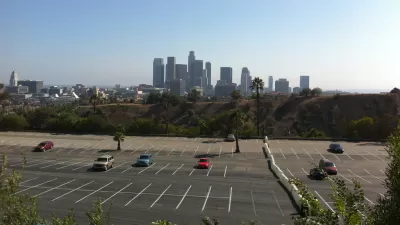An editorial in the Los Angeles Times praises the Cornfield Arroyo Seco Specific Plan as a model for how the city can break free of outdated zoning laws that force residents into obsolete living, working and commuting patterns.
After more than a decade of trying to "turn neglected neighborhoods and underused industrial properties next to the former Southern Pacific rail yard north of downtown — known as the Cornfield — into a collection of new urban zones," the Cornfield Arroyo Seco Specific Plan moved one step closer to passage this week with the approval of the City Council's planning committee.
As Los Angeles embarks on a long-overdue update to its 1946 zoning code, the Times points to the "smart land use model" and its four zoning types as worthy of emulating city-wide.
"There is a greenway zone, oriented toward enhancing the river as the neighborhood's frontyard. There is an urban village zone, focused on housing and other residential use, with some ground-floor retail. There is a denser urban center zone, close to rail stations, geared for job-creating uses but with residential space included. And there is an urban innovation zone, with flexible space geared toward anything from artists' studios to light manufacturing."
"The market has for years been demanding just those types of development in Los Angeles, and builders have been trying to respond — but have been getting stuck in variance hearings, lawsuits and community protests, development by development."
"The new zones and the new specific plan cut through that process. They bring that rarest of commodities to the Los Angeles land-use process: certainty."
FULL STORY: A model for L.A. planning

Planetizen Federal Action Tracker
A weekly monitor of how Trump’s orders and actions are impacting planners and planning in America.

Maui's Vacation Rental Debate Turns Ugly
Verbal attacks, misinformation campaigns and fistfights plague a high-stakes debate to convert thousands of vacation rentals into long-term housing.

Restaurant Patios Were a Pandemic Win — Why Were They so Hard to Keep?
Social distancing requirements and changes in travel patterns prompted cities to pilot new uses for street and sidewalk space. Then it got complicated.

In California Battle of Housing vs. Environment, Housing Just Won
A new state law significantly limits the power of CEQA, an environmental review law that served as a powerful tool for blocking new development.

Boulder Eliminates Parking Minimums Citywide
Officials estimate the cost of building a single underground parking space at up to $100,000.

Orange County, Florida Adopts Largest US “Sprawl Repair” Code
The ‘Orange Code’ seeks to rectify decades of sprawl-inducing, car-oriented development.
Urban Design for Planners 1: Software Tools
This six-course series explores essential urban design concepts using open source software and equips planners with the tools they need to participate fully in the urban design process.
Planning for Universal Design
Learn the tools for implementing Universal Design in planning regulations.
Heyer Gruel & Associates PA
JM Goldson LLC
Custer County Colorado
City of Camden Redevelopment Agency
City of Astoria
Transportation Research & Education Center (TREC) at Portland State University
Jefferson Parish Government
Camden Redevelopment Agency
City of Claremont



























